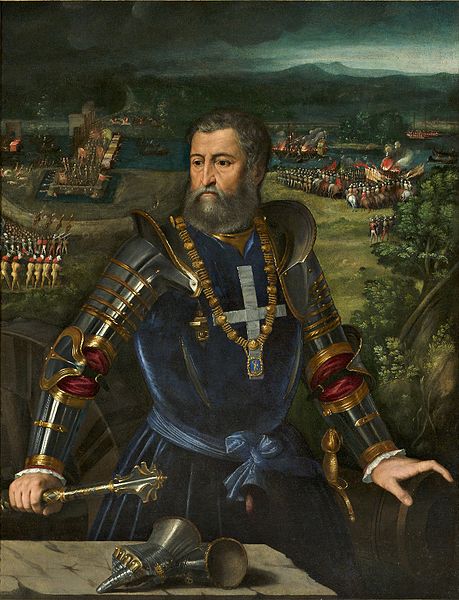The painting celebrates the military skills of Duke Alfonso I portrayed in the guise of a valiant commander. Alfonso wears combat armour, a large cross stands out on his chest and on it shines the golden collar made of small shells joined by a double cord from which hangs a medal depicting St. Michael the Archangel defeating the dragon. It was directly the King of France who honoured the most valiant and important nobles and leaders with the necklace of the Order of St. Michael, which is why it was proudly displayed in official portraits. The Duke’s hands express the strength of the condottiere: the left rests on the mouth of a cannon, while the right wields a toothed club with power. In the foreground on a marble surface are the iron gloves of armour: the outstretched right index finger represents the symbol of command. The concentrated gaze, the head turning to the left while the body is still outstretched to the right are elements that depict the Duke in the moment when he is ready to take action.
Behind him is depicted a battle, probably the most important fought by Alfonso with his brother Ippolito at his side, which will go down in history as the ‘Victory of Polesella’ in which the Este land army defeated the fearsome Venetian naval fleet. The battle was part of the League of Cambrai, an alliance led by the Papal States against Venice, in which the Duke was appointed Gonfaloniere of the Church in 1509. After the League’s first victories Alfonso reconquered the territories of Polesine and Rovigo, but the powerful Venetian army managed to take back these territories and came dangerously close to Ferrara. Este artillery managed to stop the Venetians near Pontelagoscuro, forcing them to moor their fleet between Polesella and Guarda Veneta. But there was no time to lose, as the Venetians began to build bastions to protect their position and wait for the right moment to attack the city of Ferrara. Familiarity with the area, bad weather and the strategic use of the renowned Este artillery were the factors that led the Duke to victory. The heavy rains had flooded the Po River, and the Venetian boats that stopped along the river, following the rising waters, had risen almost to the banks, so that their sides were exposed and vulnerable. The Este troops immediately gained a strategic position, hurriedly and secretly bringing in artillery from Ferrara: on the night of 21-22 December 1509, Ippolito, alone in command of the troops, ordered an attack on the Venetian fleet, almost totally destroying it. At the end of the battle, the Ferrara army captured fifteen Venetian galleys and other vessels that were triumphantly brought into the city.
The execution and dating of the painting are still debated, but it is possible to indicate 1528 as a post quem date given that in that year Alfonso received the necklace of the Order of St. Michael from the King of France. Most recent critics agree that the work is by Dosso Dossi, probably with the help of his brother, while other critics believe the painting was executed by their workshop.







